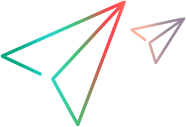Web Add-in
You can use the Web Add-in to test HTML user-interface objects (controls).
The following tables summarize basic information about the Web Add-in and how it relates to some commonly-used aspects of UFT One. This information is also relevant for all child add-ins that extend the Web Add-in.
|
General Information |
|
|---|---|
|
Add-in Type |
Much of the functionality of this add-in is the same as other Web-based add-ins. |
|
Supported Environments |
For details on supported Web browsers and versions, see the UFT One Support Matrix. |
| Child Add-ins |
|
|
Test Object Methods and Properties |
The Web Add-in provides test objects, methods, and properties that can be used when testing objects in Web applications. For details, see the Web section of the UFT One Object Model Reference for GUI Testing. |
|
Extending the Web Add-in |
Web Add-in extensibility enables you to develop support for testing third-party and custom Web controls that are not supported out-of-the-box by the UFT One Web Add-in. |
|
Other |
|
|
Testing in browsers on the cloud (UFT One version 2023 and later) |
You can run your Web tests, including tests created using UFT One version 2022 and earlier, on cloud browsers provided by Digital Lab. To run a web test on a cloud browser, do the following:
For details on setting up cloud browsers on Digital Lab, see the Digital Lab (UFT Mobile) Help Center. Note: You can run tests on cloud browsers, but you cannot spy on applications, record steps, or view the application as the test runs. For more details on the scope of web testing on cloud browsers, see Running on cloud browsers. |
| Known issues | Known issues - Web Add-in |
| Prerequisites | |
|---|---|
|
Opening Your Application |
You might need to open UFT One before opening your Web application. |
| Testing in Mozilla Firefox |
The Micro Focus UFT Agent Extension for Firefox is supported from Firefox versions 54 and higher. Note:
|
| Testing in Google Chrome |
|
| Testing in Microsoft Edge (Chromium-based) |
To record and run tests on Microsoft Chromium-based Edge browsers, you must install the Micro Focus UFT Agent Chromium Edge extension. For details, see Enable the Micro Focus UFT Agent extension on Microsoft Edge (Chromium-based). UFT One supports the stable and beta Chromium Edge versions. When UFT One opens the browser, it opens the stable version, if installed. Otherwise, it opens the beta version, if installed. Test local HTML pages in Chromium Edge, you must make additional configuration changes. For details, see Enable UFT One to test local HTML pages in Microsoft Chromium Edge. |
| Testing in Microsoft Edge Legacy |
|
| Testing in Apple Safari on a Remote Mac | See Work with Apple Safari on a remote Mac computer. |
|
Add-in Dependencies |
None |
|
Configuration |
|
|---|---|
|
Configuration Options |
Use the Web pane. |
|
Record and Run Settings |
Use the Web tab. |
|
Test Settings |
Use the Web pane. |
|
Custom Active Screen Capture Settings |
Use the Web section. |
|
Application Area Additional Settings |
Use the Web pane. |
 See also:
See also:
- Web Add-in extensibility
- Event recording configuration for Web objects
- Manage custom Web event recording configurations
- Manage listening and recording events
- Test Web apps on multiple browsers
- Cross-platform testing
- Set up multiple browser testing
- Enable the Micro Focus UFT Agent extension on Mozilla Firefox
- Enable the Micro Focus UFT Agent extension on Google Chrome
- Enable the Edge Agent for UFT on Microsoft Edge Legacy
- Work with Apple Safari on a remote Mac computer











